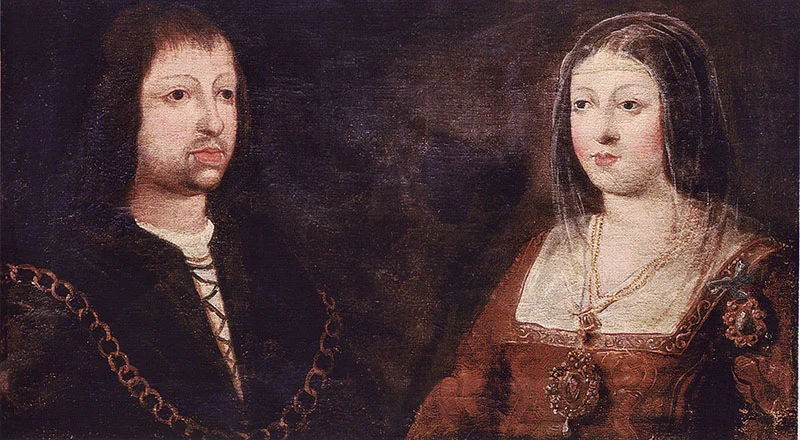Las Fiestas en Honor del Santísimo Cristo del Paño
Isabel y Fernando. Los Reyes Catolicos
Back in 1486, on 26th July, our little village of Moclín fell into the hands of the Catholic King and Queen, Isabel y Fernando. It was here, in the castle that majestically crowns this historic and very strategically placed corner of Andalucia, where Isabel held her court during the 6 years leading up to the capture of Granada. Moclín has been described as “la Corte más diminuta para la reina más grande que ha tenido España” - the smallest court for the grandest Queen that Spain had ever had.*
As a gift from a grateful Queen to the villagers of Moclín for their support during these years, a small statue of la Virgen de la Victoria, of which the Queen was particularly fond, and a canvas of Christ carrying the Cross were presented. This canvas was one of the banners used by the Christian armies during battle.
It was during the 17th Century that the religious significance surrounding the canvas began to increase. According to legend, a sacristan was miraculously cured of cataracts due to the mysterious qualities of the image of Christ and the Cross, and from then on the image became known as the “Holy Christ of the Cloth”. During the Spanish Civil War, when Moclín once again found itself on the frontier of a bloody war, the canvas was removed from its frame and rolled up for safety, and later removed from the village and stored in Granada. Once the war was over, the villagers campaigned vociferously for the return of their beloved Cristo del Paño and a copy was made so that one could be retained in Granada. To this day, rumours persist that the original was kept in Granada and the copy was sent to Moclín, rather than the other way round.
On its return to Moclín, whether copy or original, more woes beset the painting when a sudden storm struck and the upturned canvas was carried through the torrential rain. As a result, lasting damage was caused, much of which can be seen to this day.
The 5th October 1939 was the date set to celebrate the return of the Cristo del Paño, and each year the canvas is processed through the historic village streets, seen by thousands of people who come from all over Andalucia and beyond to witness what has become one of southern Spain’s most important classic religious festivals.
We first visited Moclín last year, on the last day of the festival and we wandered through dwindling crowds of visitors wondering what on earth was going on. Little did we realise, then, what an important occasion this was, and for the past twelve months we have heard much about the numbers of people who come, and how special an event it is.
Here we are, a year on and living right in the heart of the village, with doors opening onto Plaza España, a hub of the festival.
It has therefore been a very busy week for us! As if the summer hadn’t been busy enough with work and a wedding to contend with, but we are gluttons for punishment. As September marched on, with it came increasing activity surrounding the Fiesta, and we started to appreciate that this could be quite an opportunity for us to scratch the surface of village life and get a toe hold. We both decided to capture images of Moclín and create products that we could, conceivably, sell during the festival weekend. Limited edition prints, printed bags and postcards were conjured out of nowhere in record-breaking time, and outside our tiny casita we set up a mini-gallery, displaying our creative wares.
Castillo de Moclín. Illustrated by Andrew Watson
El Castillo de Moclín by Ian Rutter
In the weeks running up to the fiesta, our lovely neighbours had variously presented us with their own gifts of almonds, and delicious fruit and vegetables from their own land. By way of a return, we got baking using the gifted almonds and fresh figs from the trees in our own garden, and the results went a long way to getting us chatting to many of the villagers as they made appreciative noises and expressed surprise that we had actually baked these cakes and not just nipped to a shop and bought them.
Almond and Raspberry crumble cake
Fig Bakewell tart
It also seemed to be hugely appreciated that we were making an effort for the festival weekend, decorating the facade of the casita to look pretty with bunting and our exhibition of oil paintings, watercolours, pen and ink prints and postcards. Certainly, the display attracted a lot of interest, and our cake-fed neighbours all gave compliments as they passed by, and gradually we began to learn who was related to whom, and where they all lived. The growing party atmosphere gave us more of an opportunity to nip into the bar and chat with Ramón, the host, a little further, and order more alcoholic supplies from Carlos, who runs the little Coviran supermarket. For us, this was all something of a stride forward in our lives in Moclín as we strive to integrate ourselves into this way of life. Heaven knows what the villagers really think, as we bedecked our little flat with trimmings that would not look out of place at a garden fête in deepest England, complete with Bakewell Tart and cups of tea.
Our village pop up stall, Moclín












